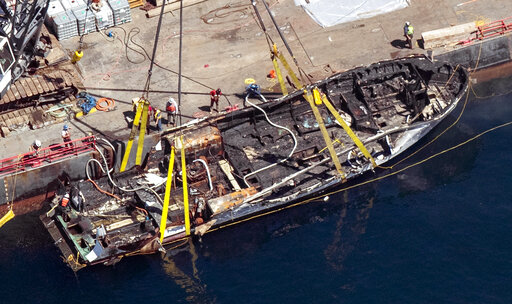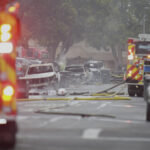LOS ANGELES — Federal authorities are expected to vote Tuesday on what likely sparked a fire aboard a scuba dive boat last year that killed 34 people off the coast of Southern California.
The pre-dawn blaze aboard the Conception is one of California’s deadliest maritime disasters, prompting both criminal and safety investigations into the Sept. 2, 2019, tragedy that claimed the lives of 33 passengers and one crew member on a Labor Day weekend expedition near an island off Santa Barbara.
The National Transportation Safety Board will vote Tuesday on their investigation’s findings, the fire’s probable cause and any recommendations that could potentially prevent further incidents.
NTSB investigators said in a report released last month that the cause remains undetermined but a possible ignition point was phones and other electronics plugged into outlets. One crew member told authorities he saw sparks when he plugged in his cellphone hours before the fire.
Five crew members, including Capt. Jerry Boylan, were asleep above deck when the fire broke out — an apparent violation of Coast Guard regulations requiring a roving watch — and managed to escape by jumping into the water. Authorities said they repeatedly tried in vain to save the others.
The surviving crew members also told investigators they were never instructed on emergency procedures.
The NTSB is a federal regulatory agency but it has no enforcement powers and can only submit its suggestions to bodies like the Federal Aviation Administration or the Coast Guard, which have repeatedly rejected some of the board’s safety recommendations after other disasters.
The Coast Guard has, however, issued additional safety recommendations following the Conception fire, such as limiting charging of lithium-ion batteries and the use of power strips and extension cords.
Officials must take into account the potential impact of a proposed recommendation on the boating community, said Kyle McAvoy, a marine safety specialist with Robson Forensic in Philadelphia.
“Where’s the optimum balance for the protection of life, property and the environment?” he said. “It’s not easy.”
In the wake of other major disasters, McAvoy said regulations and increased international awareness have occurred.
“All of these tragic events, if properly investigated, can lead to meaningful changes to prevent them from happening again,” he said.
Court documents say federal criminal charges against Boylan are imminent, though that probe is separate from the NTSB’s proceedings.
Families of 32 victims also have filed claims against the boat owners, Glen and Dana Fritzler, and the boat company, Truth Aquatics. In turn, the Fritzlers and the company have filed a legal claim to shield them from damages under a maritime law that limits liability for vessel owners. Court filings show they have offered to settle lawsuits with dozens of victims’ relatives.
Boylan and the Fritzlers, who owned three dive boats, had a good reputation with customers and the Santa Barbara boating community. Coast Guard records show the Conception had passed its two most recent safety inspections.
NTSB board member Jennifer Homendy noted how difficult it was to reach the hatch when she toured one of the Conception’s sister boats. Federal documents say the Conception’s escape hatch was typically discussed during safety briefings but passengers were not shown where it was.
About the photo: In this Sept. 12, 2019, file photo, the burned hull of the dive boat Conception is brought to the surface by a salvage team off Santa Cruz Island, Calif. The widow of Justin Dignam, one of the 34 people who died in the fire, has filed a lawsuit against the boat’s owners, making it the first claim from one of the 34 victims’ families. (Brian van der Brug/Los Angeles Times via AP, File)
Was this article valuable?
Here are more articles you may enjoy.


 Cars Are Getting Smarter. Why It Matters for Claims Professionals
Cars Are Getting Smarter. Why It Matters for Claims Professionals  Hackers Abuse Modified Salesforce App for Data Theft and Extortion, Google Says
Hackers Abuse Modified Salesforce App for Data Theft and Extortion, Google Says  Citi Reverses Course on Firing of Japan Trader Five Years On
Citi Reverses Course on Firing of Japan Trader Five Years On  Plane Crashes into San Diego Neighborhood, Setting Homes And Vehicles on Fire
Plane Crashes into San Diego Neighborhood, Setting Homes And Vehicles on Fire 